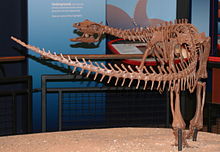Thescelosaurid
| Thescelosauridae Temporal range: Early Cretaceous–Late Cretaceous, 130–66 Ma |
|
|---|---|
 |
|
| Mounted specimen of Thescelosaurus, Burpee Museum of Natural History | |
| Scientific classification | |
| Kingdom: | Animalia |
| Phylum: | Chordata |
| Clade: | Dinosauria |
| Order: | †Ornithischia |
| Clade: | †Neornithischia |
| Family: |
†Thescelosauridae Sternberg, 1937 |
| Type species | |
|
†Thescelosaurus neglectus Gilmore, 1913 |
|
| Subfamilies | |
|
†Orodrominae Brown et al., 2013 |
|
| Synonyms | |
|
Parksosauridae Boyd, 2015 |
|
†Orodrominae Brown et al., 2013
†Thescelosaurinae Sternberg, 1937
Parksosauridae Boyd, 2015
Thescelosauridae is a clade or family of small ornithischians which have previously been generally allied to hypsilophodontids.
TMP 2008.045.0002
Although Hypsilophodontidae was interpreted as a natural group in the early 1990s, this hypothesis has fallen out of favor and Hypsilophodontidae has been found to be an unnatural family composed of a variety of animals more or less closely related to Iguanodontia (paraphyly), with various small clades of closely related taxa. "Hypsilophodontidae" and "hypsilophodont" are better understood as informal terms for an evolutionary grade, not a true clade. Thescelosaurus has been regarded as both very basal and very derived among the hypsilophodonts. One issue that has potentially interfered with classifying Thescelosaurus is that not all of the remains assigned to T. neglectus necessarily belong to it. Clint Boyd and colleagues found that while the clade Thescelosaurus included the genus Bugenasaura and the species that had been assigned to that genus, there were at least two and possibly three species within Thescelosaurus, and several specimens previously assigned to T. neglectus could not yet be assigned to a species within the genus. It appears to be closely related to Parksosaurus.
...
Wikipedia
